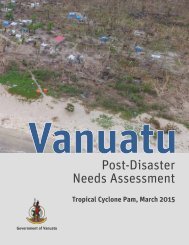Fiji
yqgk302EGjo
yqgk302EGjo
Create successful ePaper yourself
Turn your PDF publications into a flip-book with our unique Google optimized e-Paper software.
FIJI Post-Disaster Needs Assessment<br />
in a loss of 14,450,129 work days and F$351.45 million in personal income (Table 9). 33 The largest number of workdays<br />
and income loss occurred in the Northern Division followed by the Western, Central and Eastern Divisions, which follows<br />
the pattern of the extent of damage and loss in the productive sectors.<br />
Table 9: Work Days and Personal Income Lost by Division<br />
Division Work Days Lost Personal Income Lost (F$ million)<br />
Central 2,660,634 63.9<br />
Eastern 1,338,970 33.8<br />
Northern 6,093,521 148.3<br />
Western 4,357,004 105.4<br />
Total 14,450,129 351.4<br />
Source: ILO estimates based on Government of <strong>Fiji</strong> data.<br />
Several data extrapolation methods have been used to construct the baseline and to derive an estimate of the cyclone<br />
impact on Employment, Livelihoods and Social Protection (ESLP), including primary and secondary sources. 34 As the<br />
ESLP assessment is based on cross-sectoral analysis, additional data were obtained from the agriculture sector (loss<br />
of agricultural output), tourism sector (estimated duration of business interruption), manufacturing and commerce sector<br />
(number of recorded layoffs) to conduct a quantitative analysis of the cyclone’s effect on ELSP. Results were subsequently<br />
triangulated and complemented through qualitative observations in affected communities, and through interviews with<br />
representatives of the FNPF, <strong>Fiji</strong> Commerce & Employers Federation, <strong>Fiji</strong> Trades Union Congress, <strong>Fiji</strong> Sugar Cane Growers<br />
Council, <strong>Fiji</strong> Disabled Peoples Federation, <strong>Fiji</strong> National Youth Council, Women Entrepreneurs Business Council and <strong>Fiji</strong><br />
Taxi Union, to name a few. An additional rapid survey was conducted by the Integrated Human Resources Development<br />
Program, a division of the Strategic Planning Office (SPO), to gather data on the effects of TC Winston on informal microenterprises.<br />
A key finding of the assessment noted a high risk of loss in business confidence, particularly by young micro<br />
entrepreneurs. The effects of the disaster on civil servants and public employees, such as teachers, has not been taken<br />
into account, as wages continue to be paid. 35<br />
Table 10 presents the number of work days lost and income loss by sector, with a large proportion of personal income<br />
loss in the agriculture sector (F$298.16 million), which has a significant proportion of workers or 44.2 percent of the<br />
economically active population. 36<br />
Table 10: Work Days and Personal Income Lost by Productive Sectors and Transport Sector<br />
Division Work Days Lost Personal Income Lost (F$ million)<br />
Agriculture 12,851,608 298.2<br />
Commerce 498,149 17.1<br />
Manufacturing 585,873 18.5<br />
Tourism 495,021 17.0<br />
Transport a 19,478 0.7<br />
Total 14,450,129 351.5<br />
Source: ILO estimates based on Government of <strong>Fiji</strong> data.<br />
Social Protection Post-TC Winston<br />
In response to TC Winston, the government has been using existing social welfare schemes to efficiently disburse cash to<br />
vulnerable groups and inject much needed cash into the economy. On March 18, 2016, a total of F$19.9 million (US$9.4<br />
million) was disbursed under three social protection programmes. Under the PBS, 22,802 households were paid a lump<br />
sum of F$600, or the equivalent of F$200 for three months. 17,782 pensioners of the SPS over the age of 68 received an<br />
33<br />
The PDNA Guidelines note that as GDP losses are usually expressed in terms of annual GDP, this estimate refers to the amount of work<br />
(e.g., workdays) or work income lost in the year of the disaster and following years, and does not distinguish between jobs completely lost,<br />
jobs temporarily suspended or jobs with reduced income. Part of this loss might be offset in case of a speedy recovery of the productive<br />
sectors.<br />
34<br />
Secondary sources included the Population and Labour Force Survey 2014, the 2007 Census of Agriculture, the 2009 National Population<br />
and Housing Census, the 2009-2012 Decent Work Country Programme, and the 2013-14 HIES Preliminary Findings – Release 1.<br />
35<br />
Civil servants and other public employees have been stretched to capacity in trying to fulfil the demands caused by TC Winston.<br />
36<br />
ILO, ADB. <strong>Fiji</strong> Creating Quality Jobs: Employment Diagnostic Study.<br />
Tropical Cyclone Winston, February 20, 2016<br />
33



